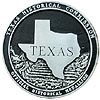| |
|
|
Site of an Early Barbed Wire Fence in the Panhandle |
|
 |
|
SH 217, about one mi East of Courthouse, Canyon,
TX,
USA
Latitude & Longitude:
34° 58' 49.34318999988",
-101° 54' 18.5288500008"
|
| |
| |
|
Texas State
Historical Marker |
In the latter 1880s, when fencing was needed in the treeless Texas Panhandle, the solution proved to be barbed wire. Joseph F. Glidden of Illinois devised and by 1876 was manufacturing (with I. L. Ellwood) the first really practical barbed wire on the market. H. B. Sanborn was sent to Texas as their agent, and remained to become a builder of the Panhandle. Wanting free access to water and grass, ranchers at first resisted fencing. Cowboys disliked it, as fewer range riders were needed on fenced lands. The old-timers grew bitter, because of blocked trails -- herds had to be hauled rather than driven to market. Yet, newcomers wanted fencing, in oder to have use of land purchased for ranching. Merchants and city-builders wanted fences, to assure settlement. The T-Anchor, owned by Jot Gunter and William B. Munson, real estate investors of Grayson County, built a line fence on this site in 1881, enclosing a 240,000-acre horse pasture. Also, built in this area, by popular subscription, was a drift fence to hold cattle back from wandering south in blue northers and blizzards. Barbed wire gradually came into general use. It saved the cattle industry, because improvements in breeding and feeding were possible on fenced ranges. (1968)
This page last updated: 7/15/2008 |
Site of an Early Barbed Wire Fence Historical Marker Location Map, the Panhandle Historical Marker Location Map, Canyon, Texas
|
|
|
|


